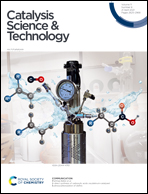Metal–support interaction-modulated catalytic activity of Ru nanoparticles on Sm2O3 for efficient ammonia decomposition†
Abstract
Development of efficient catalysts is important for production of COx-free hydrogen from ammonia decomposition. Herein, a highly active catalyst with uniform Ru nanoparticles dispersed on Sm2O3 nanorods is developed via a facile precipitation method. Under a relatively high weight hourly space velocity of 30 000 mL g−1 h−1, Ru/Sm2O3 can catalyze ammonia decomposition reaction with a H2 formation rate as high as 25.9 mmol gcat−1 min−1 at 450 °C, which is superior to most of conventional oxide-supported Ru catalysts. Moreover, we find that the activity of Ru/Sm2O3 is highly dependent on the preparation method. The Ru/Sm2O3 catalyst prepared by precipitation method exhibits much higher activity than the Ru/Sm2O3 analogues by impregnation and solid milling methods. Characterization results demonstrate that the superior catalytic performance of Ru/Sm2O3 achieved from precipitation method should originate from much enhanced interaction between Ru nanoparticles and Sm2O3 support. These findings offer promise to explore Ru/Sm2O3 catalyst as a new kind of efficient catalyst for ammonia decomposition and to improve the catalytic performance by modulating the metal–support interaction of the catalyst.



 Please wait while we load your content...
Please wait while we load your content...